Peak District
Explore hidden histories, historic photos, and things you never knew about Peak District from the collections and archives of Historic England.
Discover your local listed buildings and places
Introducing some of Peak District's most historic sites, included in the National Heritage List for England. Some of these captions have been summarised by AI. Click through for the official List entry. Skip this section and go to place by numbers
Pilsbury Castle Hills motte and bailey castle
Hartington Town Quarter
Pilsbury Castle Hills is a well-preserved motte and bailey site, crucial for studying Norman Britain and the feudal system, with intact archaeological remains.
Redmires First World War Training Area
Sheffield
First World War Training Area provided for the use of the Sheffield City Battalion, comprising numerous in-filled trench complexes and fieldworks dug late- 1914–16.
Lyme Park
Disley
Lyme Park is a historic estate featuring a medieval deer park, gardens, and notable buildings developed from the 17th to 20th centuries, managed by the National Trust.
Navio Roman fort and vicus
Hope
Navio Roman fort and vicus are critical to understanding Roman military strategy, showcasing preserved archaeological remains crucial for studying military-civilian interactions in Midland...
Bailey Hill motte and bailey castle, High Bradfield
Bradfield
Bailey Hill motte and bailey castle, surviving from the 12th century, offers insights into Norman Britain's medieval fortifications and strategic settlement patterns.
Chatsworth House
Baslow and Bubnell
Chatsworth House, a historic country house in England, features gardens and landscapes by prominent designers like Lancelot Brown, Joseph Paxton, and Jeffry Wyatville, reflecting centuries...
Thornbridge Hall
Ashford in the Water
Thornbridge Hall's gardens, originally designed in the late 19th and early 20th centuries, surround a historic house transformed through Jacobean-style renovations, featuring extensive...
Magpie, Dirty Red Soil, Maypit, Horsesteps and Great Red …
Ashford in the Water
Magpie, Dirty Red Soil, and related lead mines are key historical sites illustrating Derbyshire's mining tradition and 19th-century technological developments.
Conksbury deserted medieval settlement
Over Haddon
Conksbury is a well-preserved medieval settlement in Derbyshire, notable for its archaeological significance and extensive historical documentation, including references from the Domesday...
Roman fortlet 320m east of Highstones
Tintwistle
Roman fortlets were small military enclosures used from the first to fourth century AD for temporary troop housing, positioned for strategic advantages, significant for understanding Roman...
Pike Low bowl barrow
Derwent
Pike Low bowl barrow is a historically significant and well-preserved Peak District barrow, representing diverse prehistoric burial practices without excavation disturbance.
Tideslow Rake lead rake and lime kiln
Little Hucklow
Tideslow Rake is a visually impressive lead mining site in Derbyshire, featuring well-preserved historical mineworks and a lime kiln for creating quicklime.
Bonsall Leys lead mines
Bonsall
The Bonsall Leys lead mines highlight post-medieval Derbyshire's small-scale, low-tech lead mining, with complex and diverse remnants showing historical and technological development.
North Lees Chapel
Hathersage
North Lees Chapel, potentially dating from the 16th century, is a significant archaeological site as the sole remaining Roman Catholic field chapel in the Peak District National Park.
Roman Catholic Church of St Michael the Archangel, bounda…
Hathersage
A Catholic chapel, likely incorporating the remains of the late-C17 Mass House, rebuilt in 1798-1806, with C19 alterations and extensions, and internal remodelling during the C20 and C21.
Underhill
Holme Valley
Earth sheltered house, designed in 1969 and constructed in 1973-5, by Arthur Quarmby as his family home.
Slight univallate hillfort and two bowl barrows on Mam Tor
Castleton
The Mam Tor hillfort is a significant slight univallate hillfort with intact earthworks and archaeological features, illustrating Bronze to Iron Age transitions and ancient burial practices.
Wayside cross on Bradfield Moor known as New Cross
Bradfield
Wayside crosses served as religious symbols and waymarkers from the 9th to 15th centuries, with New Cross displaying a unique, preserved socle in its original location.
Sheepwash Bank and Dennis Knoll prehistoric settlement an…
Hathersage
Sheepwash Bank and Dennis Knoll are crucial Bronze Age sites on Derbyshire's East Moors, showcasing extensive, well-preserved settlement and agricultural features significant to prehistoric...
Chatsworth Estate Office and Village Institute
Edensor
The building, dated from 1776-7 and attributed to Joseph Pickford, serves as the Chatsworth Estate Office and Village Institute, originally intended for wealthy travellers.
Wayside and boundary cross known as Lady's Cross
Holmesfield
Lady's Cross, a medieval wayside and boundary cross, is a significant marker of crossroads and boundaries, exemplifying historical religious customs and settlement patterns.
Fox Hole Cave
Hartington Middle Quarter
Fox Hole Cave is a significant Palaeolithic site in Derbyshire, known for well-preserved artefacts and in situ deposits, dating human activity to the Late Glacial interstadial.
Cackle Mackle and Stadford Hollow lead mines on Longstone…
Great Longstone
Cackle Mackle and Stadford Hollow mines represent a well-preserved example of Derbyshire's lead mining, featuring diverse archaeological remains that illustrate historically significant...
Fin Cop promontory fort, bowl barrow and eighteenth centu…
Ashford in the Water
Promontory forts are rare Iron Age settlements, valued for understanding prehistoric social organization.
Nether Haddon medieval settlement and part of an open fie…
Nether Haddon
Nether Haddon medieval settlement, with its well-preserved remains, reveals significant insights into medieval rural life, Romano-British field systems, and the history of lead mining.
Late prehistoric enclosed settlement known as the Old Bul…
Holme Valley
The Old Bull Ring is a well-preserved late prehistoric enclosed settlement showcasing early settlement diversity in northern England.
Late prehistoric enclosed settlement on Royd Edge, 300m n…
Meltham
The Royd Edge site is a well-preserved late prehistoric settlement, illustrating diverse enclosure types.
The Grey Ditch
Bradwell
The Grey Ditch, an early medieval boundary, is a significant archaeological site in the Peak District, offering insight into historical territorial demarcations in England.
The Bar Dyke linear earthwork
Bradfield
The Bar Dyke is a significant earthwork, likely from the Iron Age or post-Roman period, serving as a defensive structure or boundary in southern Yorkshire.
The Rutland Arms Hotel
Bakewell
The Rutland Arms Hotel, a coaching inn of 1804 built for the Duke of Rutland, extended in 1895.
Danebower Colliery ventilation chimney, 750m north east o…
Macclesfield Forest and Wildboarclough
The Danebower Colliery ventilation chimney is a rare, well-preserved example of 19th-century coal mining architecture and one of only nine surviving in England.
Lord's Seat bowl barrow
Edale
Lord's Seat bowl barrow embodies prehistoric burial traditions with its preserved structure, revealing societal beliefs from 2400-1500 BC in the Peak District, Derbyshire.
Kinderlow bowl barrow
Hayfield
Kinderlow bowl barrow is a well-preserved Peak District barrow from the Bronze Age, notable for its intact archaeological remains and prominent hilltop location.
Wayside and boundary cross known as Edale Cross
Hayfield
Edale Cross, set in the Peak District, is a medieval wayside and boundary cross marking ancient routes and royal forest edges, reflecting religious and cultural heritage.
Arbor Low henge, large irregular stone circle, linear ban…
Middleton and Smerrill
Arbor Low henge is a well-preserved ritual site featuring a large stone circle, diverse features, and a Class II designation for its national importance.
Explore more
Search for more listed placesPeak District through time
This timeline shows the first period of use for buildings and places on the National Heritage List for England, just one of the details recorded for every list entry. Click around to see how Peak District changes over time. Skip this section and go to aerial photos
Prehistoric Before AD 43
Prehistory covers a million years of human occupation before the Roman invasion, from hunter-gatherers of several human species, including Neanderthals, to more recent herders and farmers. It was a time of developing technologies and belief systems, involving contact with and migration from Europe, all reflected in the variety of artefact and monument types characteristic of particular prehistoric periods.
Roman AD 43 to AD 410
Britain was invaded by four legions of the Roman army in AD 43, who relatively rapidly conquered England from landing points in Kent. Parts of Wales and Scotland soon followed.
Roman culture brought urbanism, monumental buildings, wide-ranging religious beliefs, writing, and strong social hierarchy. The Roman administrative system was withdrawn in AD 410.
Early medieval AD 410 to AD 1066
This period, often associated in England with Anglo-Saxons and Vikings, saw a reduction in urban living from the Roman period and increased migration from northern Europe.
Traces of this period can be found in cemeteries, particularly in artefacts and in some of the very early churches, as this period also saw the growth of Christianity in Britain.
Medieval AD 1066 to AD 1540
This period, sometimes known as the Middle Ages, began with the Norman invasion in AD 1066. It saw a significant rise in military and defensive buildings such as castles and earthworks, as well as religious houses dominating a largely agricultural landscape.
The monarchy and Church dominated the period, which also saw the break with the Roman Catholic Church and the English reformation.
Post medieval AD 1540 to AD 1901
The Post-Medieval period brought seismic changes to life in England, with religious reformation leading to the democratization of worship and the destruction of hundreds of religious houses.
In parallel, there was a huge expansion of scientific study and enlightenment that permanently altered the nation's social structure and landscape. Industrialization and mass production lead to wider global trade, emigration, and immigration.
20th century AD 1901 to AD 2000
The 20th century saw an incredible expansion of England's transport networks, with suburban growth shadowing rapid infrastructural expansion. The establishment of state schools, hospitals, and modern technical colleges, with new architectural styles, radically changed the appearance of towns and cities.
Two catastrophic world wars and the 1918 pandemic also brought unprecedented change, altering England's built environment and social structures forever.
Prehistoric Before AD 43
Prehistory covers a million years of human occupation before the Roman invasion, from hunter-gatherers of several human species, including Neanderthals, to more recent herders and farmers. It was a time of developing technologies and belief systems, involving contact with and migration from Europe, all reflected in the variety of artefact and monument types characteristic of particular prehistoric periods.
Roman AD 43 to AD 410
Britain was invaded by four legions of the Roman army in AD 43, who relatively rapidly conquered England from landing points in Kent. Parts of Wales and Scotland soon followed.
Roman culture brought urbanism, monumental buildings, wide-ranging religious beliefs, writing, and strong social hierarchy. The Roman administrative system was withdrawn in AD 410.
Early medieval AD 410 to AD 1066
This period, often associated in England with Anglo-Saxons and Vikings, saw a reduction in urban living from the Roman period and increased migration from northern Europe.
Traces of this period can be found in cemeteries, particularly in artefacts and in some of the very early churches, as this period also saw the growth of Christianity in Britain.
Medieval AD 1066 to AD 1540
This period, sometimes known as the Middle Ages, began with the Norman invasion in AD 1066. It saw a significant rise in military and defensive buildings such as castles and earthworks, as well as religious houses dominating a largely agricultural landscape.
The monarchy and Church dominated the period, which also saw the break with the Roman Catholic Church and the English reformation.
Post medieval AD 1540 to AD 1901
The Post-Medieval period brought seismic changes to life in England, with religious reformation leading to the democratization of worship and the destruction of hundreds of religious houses.
In parallel, there was a huge expansion of scientific study and enlightenment that permanently altered the nation's social structure and landscape. Industrialization and mass production lead to wider global trade, emigration, and immigration.
20th century AD 1901 to AD 2000
The 20th century saw an incredible expansion of England's transport networks, with suburban growth shadowing rapid infrastructural expansion. The establishment of state schools, hospitals, and modern technical colleges, with new architectural styles, radically changed the appearance of towns and cities.
Two catastrophic world wars and the 1918 pandemic also brought unprecedented change, altering England's built environment and social structures forever.
Aerial photos of Peak District
Aerial photography helps reveal secrets of England's changing landscapes that are impossible to see from the ground. Skip this section and go to archive images

Swythamley Hall
Swythamley Park, Swythamley Hall, 1939

Swythamley Hall
Swythamley Hall and grounds, Swythamley Hall, 1939

Bakewell
Haddon Hall, Bakewell, 1927
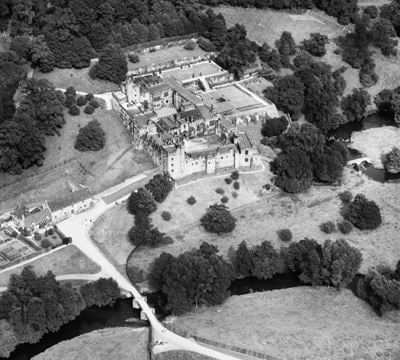
Bakewell
Haddon Hall, Bakewell, 1953
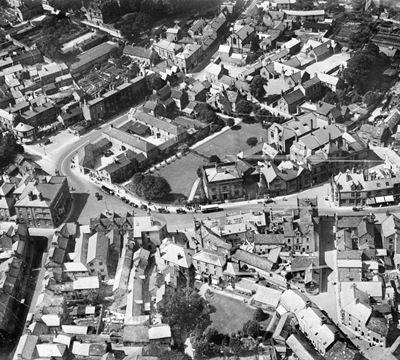
Bakewell
The town centre, Bakewell, 1927

Bakewell
The town centre, Bakewell, 1948

Ecton
The Hillocks (The Castle), Ecton, 1950
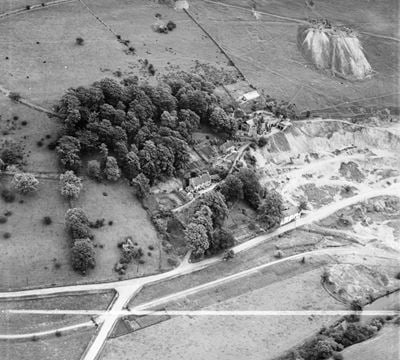
Ecton
The Hillocks (The Castle) and the hamlet, Ecton, 1950

Bakewell
Lumford Mill, Bakewell, 1927

Bakewell
Lumford Mill, Bakewell, 1927
Peak District in the Historic England Archive
The Historic England Archive cares for over 15 million images, dating from the 1850s to the present day. Discover stunning images of Peak District's past. Skip this section and go to stories about heritage
Charles George Harper Collection
Derbyshire Dales, Derbyshire
Date created: 1892 - 1933
Interior view of the chapel at Haddon Hall
Eileen ‘Dusty’ Deste Collection
Hope Valley, High Peak, Derbyshire
Date created: 1966 - 1974
A view over Ladybower Reservoir
Eric de Mare
Derbyshire Dales, Derbyshire
Date created: 1945 - 1980
General view of the Sheepwash Bridge in Ashford in the Water.
John Gay Collection: Rural Life
Monsal Dale, Derbyshire Dales, Derbyshire
Date created: 1959
A scenic view of Monsal Dale in Derbyshire, looking north-west along the River Wye in the valley from a high viewpoint at Monsal Head near Little...
John Gay Collection: Counties
Woodhead Reservoir, High Peak, Derbyshire
Date created: 1965
Woodhead Reservoir seen from the north with Bleaklow in the background
John Laing Collection
Lyme Park, Cheshire East
Date created: 11 Jun 1992
A group portrait of members of Laing's North West Senior Citizens Club during a visit to Lyme Park
London, Midland and Scottish Railway Company
Derbyshire Dales, Derbyshire
Date created: 05 Jul 1926
Cows lying in a field on the south-east side of Thorpe Cloud, with a stone cottage standing at the foot of the limestone hill
Alfred Newton and Sons
Dove Dale, Derbyshire Dales, Derbyshire
Date created: 1896 - 1920
GENERAL LANDSCAPE VIEW SHOWING LIONS ROCK AND RIVER
Nigel Temple Collection of Postcards of Parks and Gardens
Derbyshire Dales, Derbyshire
Date created: 1900 - 1930
EXTERIOR VIEW OF FRONT
John Gay Collection: Rural Life
Derbyshire Dales, Derbyshire
Date created: 1959
A picturesque view of a river in a valley, at an unidentified location in the Derbyshire Dales, with a couple walking beside the riverbank and a...
London, Midland and Scottish Railway Company
Manifold Valley, Staffordshire Moorlands, Staffordshire
Date created: 14 Aug 1895
A view looking across the Manifold Valley towards Thor's Cave
Alfred Newton and Sons
Dove Dale, Derbyshire Dales, Derbyshire
Date created: 1896 - 1920
GENERAL LANDSCAPE VIEW SHOWING RIVER RUNNING ALONG VALLEY FLOOR
Stories about heritage in your local area
Historic England publishes news, blogs, research, videos, and podcasts celebrating England's rich heritage. Discover the stories we have about Peak District. Skip this section and go to education
7 Places to Celebrate the National Trust
Mentions Lyme Park
The National Trust was founded on 12 January 1895 by Octavia Hill, Sir Robert Hunter and Hardwicke Rawnsley.
6 Evocative Literary Locations
Mentions Chatsworth House
Many authors and the characters they created have lived in and loved England, evoking streetscapes, landscapes and buildings throughout their work.
How to Lay Out a Garden: the Legacy of Edward Kemp (1817 -1891)
Mentions Chatsworth House
Edward Kemp was one of the most prolific and influential landscape designers of the Victorian era.
It’s Love – actually!
Mentions Chatsworth House
Explore some historic places that have provided a backdrop to some of our favourite romance films.
8 Images of a Frosted England
Mentions Peveril Castle Curtain Walls and Fragmentary Foundations
Baby, it’s cold outside!
“I’m Sorry But What Is a Scheduled Monument?”
Mentions Arbor Low henge, large irregular stone circle, linear bank and bowl barrow
We’ve had Scheduled Monuments (sometimes known as Ancient Monuments) since 1882 when the Ancient Monuments Protection Act was passed.
7 Buildings That Tell the Story of the Brontë Sisters
Mentions North Lees Hall, The Vicarage and Garden Walling
Here we look at the list entries updated in 2016 to reflect their associations with the Brontë family.
Planting Trees for the Future Whilst Protecting the Past
Mentions Peak District
Developing new datasets to ensure that the right tree is planted in the right place.
Supporting Historic England’s Strategic Agenda from the Air
Mentions Peak District
Our Apprentice Aerial Survey Investigator reports on the vital work of monitoring heritage and discovering new sites.
30 Years of Flying in the North
Mentions Peak District
Celebrating the achievements of Historic England's aerial recording programme in the North of England.
Rare First World War Practice Trenches in Gosport Scheduled
Mentions Redmires First World War Training Area
The well-preserved site at Browndown, Gosport in Hampshire has been designated as a scheduled monument.
Progress for Peatlands
Mentions Peak District
The historic and natural importance of peatlands with respect to tackling climate change.
Pilot Scheme Success in Restoring Historic Barns
Mentions Peak District
Bringing life back to traditional agricultural buildings within the participating National Park boundaries.
New Listings Announced to Celebrate 70 Years of Protecting England's Historic Buildings
Mentions Underhill, Peak District
New listings mark 70th anniversary of the listed building system
Peak District's social history through photos
Over 10,000 images from the Historic England Archive have been specially selected and re-captioned for teachers, students, and anyone who wants to learn more about their local area. Skip this section and go to grant-aided places
Workers housing, Bradfield, South Yorkshire
Period: Georgian (1714 - 1836)
This terrace of houses known as Riverside Cottages, was built in the 18th century. It was altered in the mid-to-late 19th century.
Workers housing, Bradfield, South Yorkshire
Tomb of Catherine Mompesson, Chrurchyard, Eyam, Derbyshire
Period: Stuart (1603 - 1713)
Catherine Mompesson died during the outbreak of plague in 1666. She was the wife of the Vicar of Eyam.
Tomb of Catherine Mompesson, Chrurchyard, Eyam, Derbyshire
The Old Original Bakewell Pudding Shop, Bakewell, Derbyshire
Period: 1920s (1920 - 1929)
A view of the front of the shop.
The Old Original Bakewell Pudding Shop, Bakewell, Derbyshire
The Great Cross, South Church Street, Bakewell, Derbyshire
Period: Anglo Saxon (Britons/English/Vikings) (410 - 1065)
The shaft of a Saxon cross dating from the early 9th century. The cross that would have been at the top of the shaft is missing.
The Great Cross, South Church Street, Bakewell, Derbyshire
St Lawrences Church, Eyam, Derbyshire
Period: Georgian (1714 - 1836)
A view of the sundial which stands between two lancet windows and above a pointed doorcase. It is dated 1775.
St John's Hospital, South Church Street, Bakewell, Derbyshire
Period: Stuart (1603 - 1713)
A plaque reads 'The Hospital of St John Founded 1602'. The hospital was an almshouse.
Snitterton Hall, South Darley, Derbyshire
Period: Tudor (1485 - 1602)
A small Elizabethan mansion built in the late 16th century to an 'E' shape design which has had little alteration. It is built of local stone.
Snitterton Hall, South Darley, Derbyshire
Peak District, Derbyshire
Period: 1950s (1950 - 1959)
Three boys wading across a river in a wooded valley, possibly Dove Dale, with a dramatic hilly landscape in the distance.
Peak District, Derbyshire
Discover more
Ready for more local stories? Take a look at these other places nearby
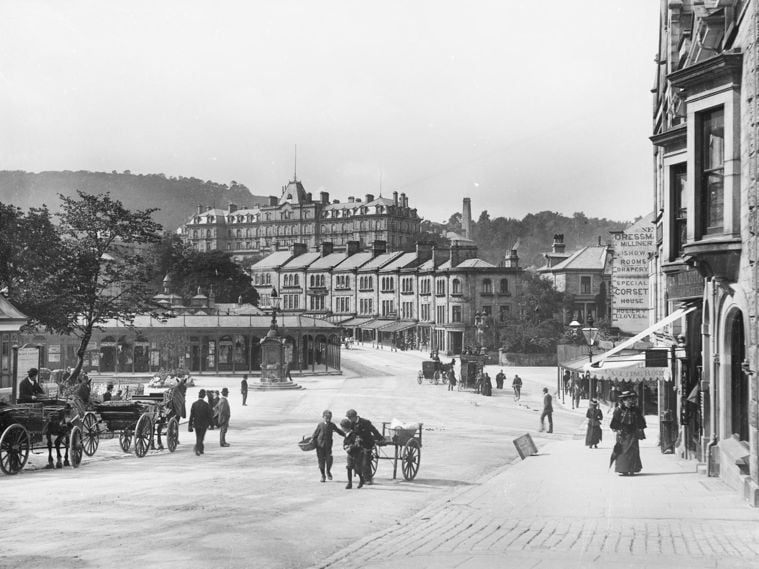
High Peak
Local Authority District
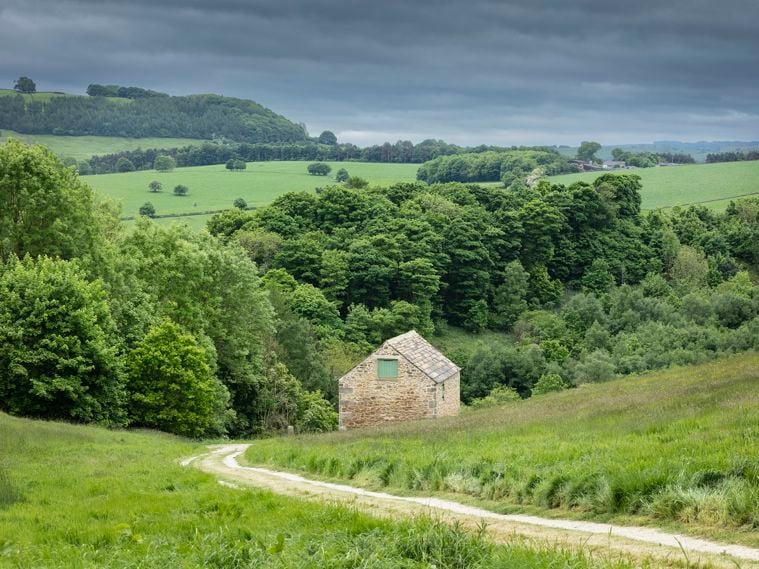
Derbyshire Dales
Local Authority District
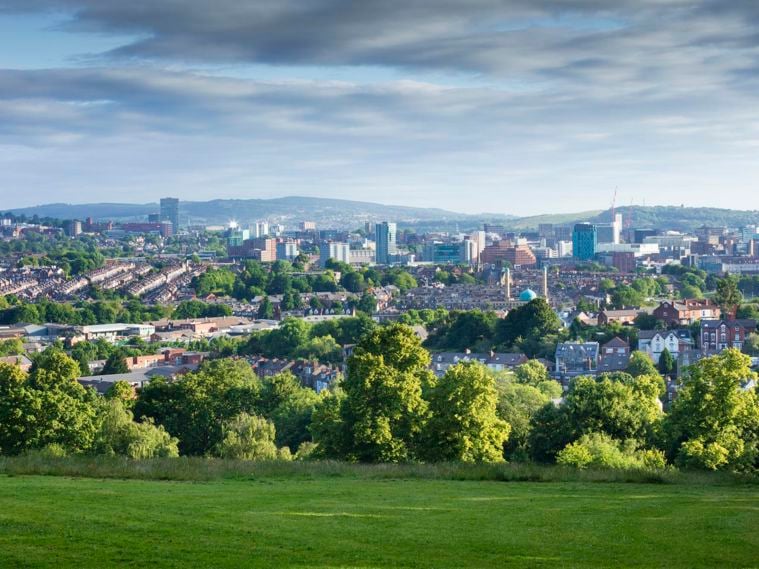
Sheffield
Local Authority District